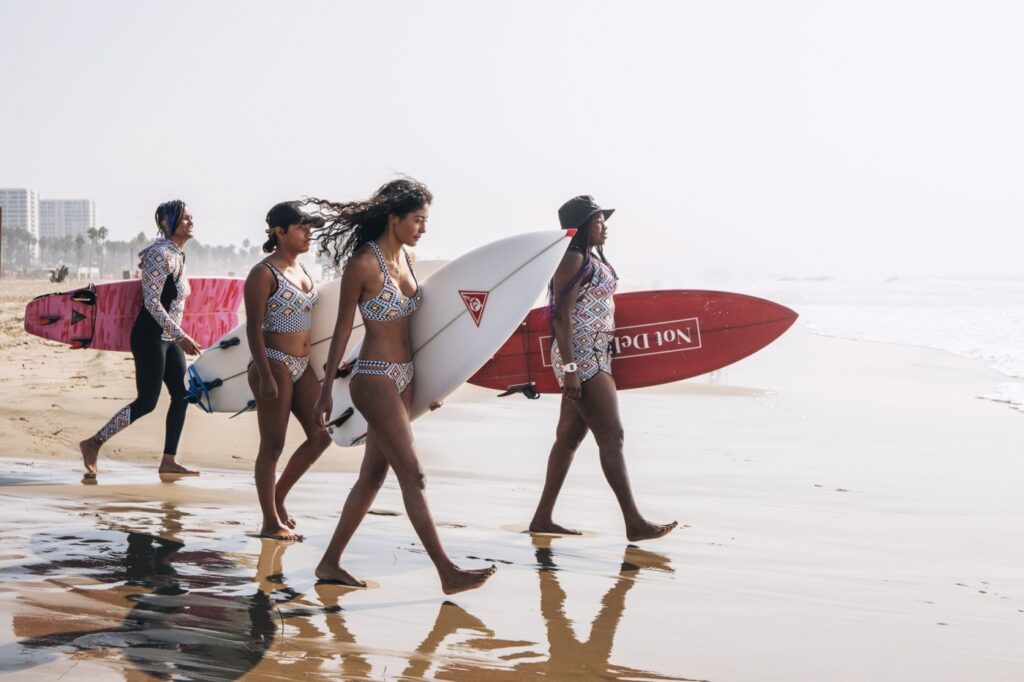
If you can’t see it, you can’t be it.
That’s a mantra Rhonda Harper, founder of Black Girls Surf, says often to convey the importance of cultural and gender diversity out in the ocean to inspire others to feel comfortable riding waves.
One mega surf brand, Costa Mesa-based Hurley, is showing support for more inclusion in the water and Harper’s mission to get more Black women to not just enjoy the waves, but to have more representation in competitive surfing.
“If I would have had an example of a professional surfer the same color as me, I would have felt comfortable as a surfer on that level,” she said.
Costa Mesa brand Hurley has launched a new apparel line with with Black Girls Surf, a non-profit that aims at promoting diversity out in the water and in competitive surfing. (Photo courtesy of Hurley)
Hurley last week launched the Hurley X Black Girls Surf Collection, with the tagline: “Helping to diversify lineups around the world.”
The collaboration, which will give a portion of the proceeds to the nonprofit, includes beach and activewear, boardshorts and even an electric bike.
Harper spent her early years in Kansas before her parents moved to California. She learned to surf as a teen while staying with her sister in Hawaii.
She started a surf camp in 2007 in Santa Monica, teaching battered women and their children how to surf. In 2008, she helped get a remembrance plaque put in place to honor Inkwell Beach and Afro-Latino surfer Nicolas Gabaldon, hailed as California’s first documented African-American and Latino surfer at a time when many beaches were segregated.
By 2014, Black Girls Surf had been born.
In more recent years, Harper, who lived in the South Bay for about 10 years, but now calls San Jose home, has dedicated herself to coaching so she can help raise the level of Black women in competitive surfing. She’s been trying to find resources for equipment and training for up-and-coming athletes who range from ages 7 to 17.
“That way, we can concentrate on the next generation of surfers going into competition,” she said, with a goal of seeing athletes the organization helps support competing on the Olympic stage in coming years.
“BGS invites surfers to both training camps and ‘board meetings,’ encompassing beginners all the way to female surfers at the expert level. It is an inclusive organization that works to further the future of females in surfing,” Hurley brand officials said previously.
“BGS’s goal is to make sure anyone who has ever wanted to surf is given the chance. In addition to having a solid roster of experienced surfers on their team, BGS ensures their athletes also have the opportunity to get an education through their sponsorship program,” they said. “These women not only get to work toward their professional surf dreams, they’re empowered through education along the way.”
Following George Floyd “solidarity in surf” paddle outs, with several held throughout Southern California in 2020, many surf brands called wanting to support BGS, Harper said.
“I had to sit down and decide which brand was going to be right for our mission,” she said. “I didn’t want a brand to come in and say ‘You’re trending, we’re going to make our money and send you out to space.’ I wanted a company that would build foundations, training, conditioning and education. I wanted someone who could understand the mission.”
According to Hurley, the partnership seeks to expand inclusivity within the sport of surfing as a whole, as it relates to race and gender, with plans to participate in events, co-sponsor athletes and share the mission of BGS with a larger audience.
The surf brand runs a Hurley Youth program, which has a global roster of young athletes and ambassadors, which is how they found BGS -– a partnership that turned out to be even more impactful than they anticipated.
“We are combining forces to tap into what both Hurley and BGS do best – lead, innovate, mentor and promote sisterhood,” brand officials said.
There’s been a noticeable change in the line up in recent years, but there’s still a long way to paddle, Harper said. “Though you’re starting to see more and more color in the line up, we aren’t there yet. We’re just starting to scratch the surface … how do these kids get access?”
If a young female surfer in Africa or even inland California wants to surf professionally, for example, Harper asks what is the route to get there? How do they pay for registration fees or boards or transportation to the beach?
Related links
New book, ‘Women on Waves,’ explores impact of females on surf culture and sport
4 female surfers who paved the way for women on waves
Local artist puts mark on historic moment in surfing
Surfers paddle out in San Clemente in solidarity against racial inequality
Sharing the stoke: Surfing Gudauskas brothers give back at home and abroad
“It’s the lack of access, that’s the biggest problem,” she said. “Surfing isn’t a cheap sport.”
In Africa, a board can cost $600, while most families live on an income of $720 a year, she said.
“These are the challenges we face,” she said. “They aren’t insurmountable. They are just your regular complications you would have if you’re trying to run a business. I don’t see it as something we can’t overcome, but people need to concentrate on how to go about it.”
